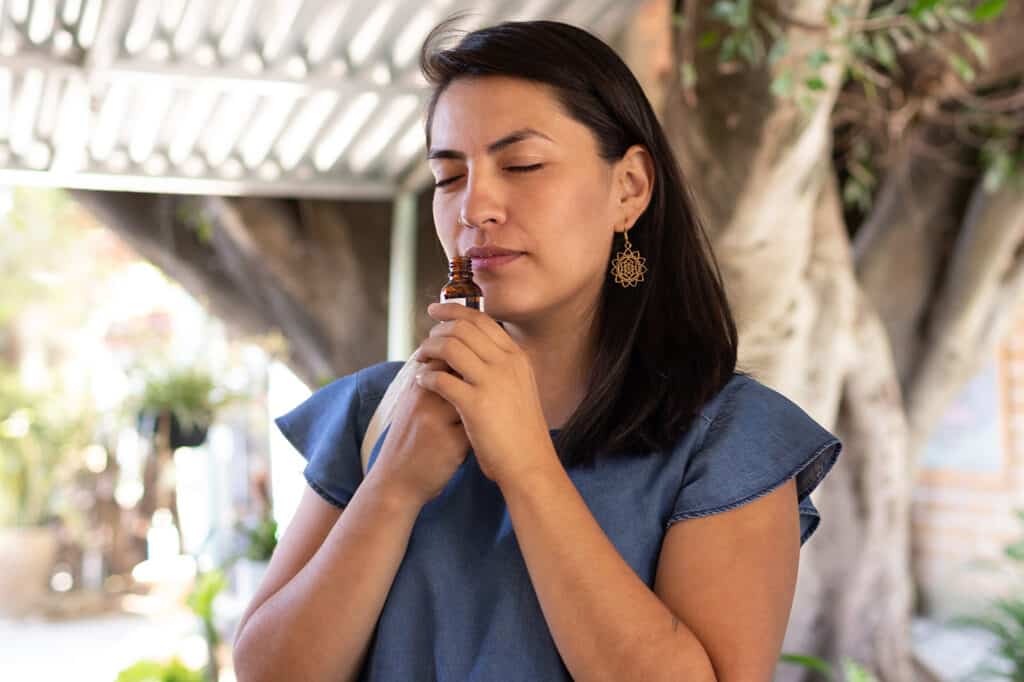Essential oils are known to help us energetically and therapeutically, as plants have been the source of medicine since the beginning of time. The practice of aromatherapy includes both energetic (mood, energy) and medicinal (pain relief, digestion, allergy, etc) support, with 3 primary ways to apply them for your healing. True, therapeutic quality essential oils are an investment, so it’s important to use them for maximum benefit.
Let’s take a look at the 3 ways to utilize essential oils for your healing.
1) Inhalation
Diffusers, inhalers, aromatherapy jewelry, mists
The fastest way for essential oils to reach the brain and blood stream is through inhalation; hence, the name “aroma”-therapy – the therapeutics are through inhalation, and this is the preferred method of application.
The olfactory nerve is the oldest and most primal of human senses, and connects to the limbic system of the brain, which houses emotion and memory. Behavior, motivation, long-term memory, and our sense of smell also relate to the limbic system.

When essential oils are inhaled, the molecules enter the nose, contacting the olfactory mucous membrane. Thousands of receptors identify the aroma and then sensory stimulation is sent through the olfactory bulb, which acts as an amplifier, through the olfactory nerve into the limbic system of the brain.
It takes just seconds to reach the brain and 20 minutes to an hour (or more) to enter your bloodstream, depending on the type of oil. The oils are metabolized and out of your system in approximately 2-3 hours, so re-application at approximately that frequency is recommended.
2) Skin Application
Massage oils, lotions, creams, balms, rollerballs, baths
Essential oils can also be absorbed to a certain extent through skin. Less of the essential oil’s chemicals will reach the bloodstream with skin application, but some will absorb through the skin and you may also inhale some in addition, such as with rollerballs applied to wrists and the back of hands and inhaled. This is a lovely way to supplement inhaled essential oils and obtain their benefits throughout the day in gentle ways.
While estimations vary, somewhere between 50-80% of essential oil applied topically will be absorbed into the bloodstream, but that includes the carrier oil, balm or lotion that you’ll be using with skin application. So while this is a pleasurable way to use essential oils, it’s second in effectiveness to inhalation.
One exception is that topical application is the preferred method when the goal is healing the skin – for example, using balms with oils high in esters, like chamomile, clary sage, lavender, yarrow, rose geranium, rose and helichrysum, and sesquiterpenes like Frankincense. When the goal is skin repair, you want to put the diluted essential oils directly on the skin.
3) Ingestion
Place on tongue, in food and beverages
While there’s debate in the aromatherapy community on whether it’s safe to ingest, we do not recommend it. Essential oils are powerful and potent, and may cause damage to internal organs if taken internally. It’s also an inefficient way to distribute the oils compared to inhalation, since it has to pass through our digestive tracks to reach the bloodstream. Wth the risks involved, it’s best to save your precious oils for other applications that are proven to be safe and effective.
While I’ve heard anecdotally that adding a few drops of lemon to water, or peppermint to tea, may have no adverse effects, it’s not shown to have positive ones, so it’s likely just be a waste of oil. However, if you do ingest, only use essential oils from plants that we also consume as food – ie, citrus oils (lemon, lime, tangerine, orange, grapefruit), herbs like basil, peppermint and rosemary, and spices like cardamom and cinnamon. But caution: if you do ingest, be sure to consult with a Clinical Aromatherapist to ensure you are doing it safely.
===
Since essential oils are a pure and concentrated substance that requires tremendous amounts of plant matter for each drop, protect your investment with using them in the most potent and effective ways – inhalation and in some cases, skin application.


1 thought on “Aroma Absorption: Getting essential oils into your blood & brain for healing”
As a passionate advocate for holistic wellness, I believe in harnessing the power of essential oils for healing. Inhalation is my go-to method, tapping into the primal connection between scent and emotion. Skin application adds another layer of therapeutic benefit, especially for skin healing. However, ingestion comes with risks and inefficiencies, so I advise against it. Let’s maximize the potential of these precious oils through mindful application.